Mastering Values, Leadership, and
Change» (ISBN-13: 978-1405133562)

SDTEST® has 36 different VUCA polls that calculate the 13,034 correlation values between stages of development according to the theory of Spiral Dynamics and answer options of these 36 polls.
We invite curiosity about the systemic mechanisms behind this correlation. There may be hidden variables that provide alternative explanations.
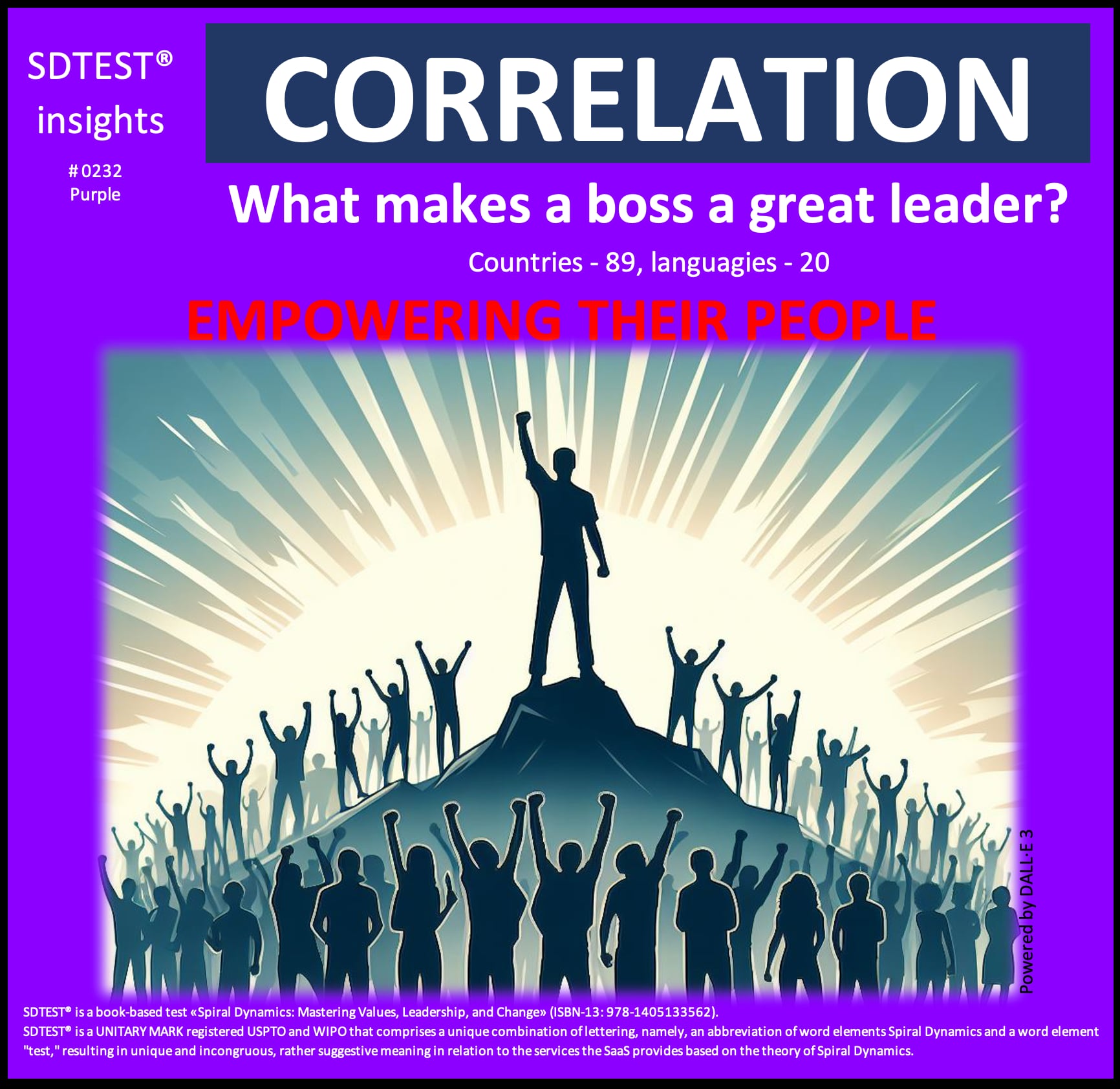
This negative correlation of -0.1109 between empowering people and the Purple stage offers intriguing insights when viewed through the lens of the Purple value system:
Organizations operating within the Purple mindset might interpret this correlation as:
These organizations might respond by:
Teams operating from a Purple mindset might approach this correlation by:
These teams might respond by:
Individuals aligned with the Purple value system might interpret this correlation as:
These individuals might respond by:
This correlation, viewed through the Purple lens, suggests that those operating at the Purple level may be less inclined to value or seek empowerment in leadership. It implies that the Purple value system's characteristics of tradition, spirituality, and communal identity align more closely with hierarchical, spiritually-guided leadership models rather than empowerment-based approaches.
Ultimately, this correlation shows the complex relationship between cultural values and leadership expectations. It reminds us that in the Purple worldview, established hierarchies' stability and spiritual significance may be seen as more critical to organizational success than individual empowerment.
This insight could spark valuable discussions about the role of cultural values in shaping leadership expectations, the challenges of implementing modern management practices in traditional settings, and how organizations can navigate the tension between ancestral wisdom and evolving leadership paradigms.
0.1242 between the I am not ready to receive less pay (0% discount) to work remotely and the Red stage.
The critical value of the correlation coefficient for a normal distribution, by William Sealy Gosset (Student) r = 0.0632. This positive correlation of 0.1242 meets the reliability criteria but does not necessarily imply causation.
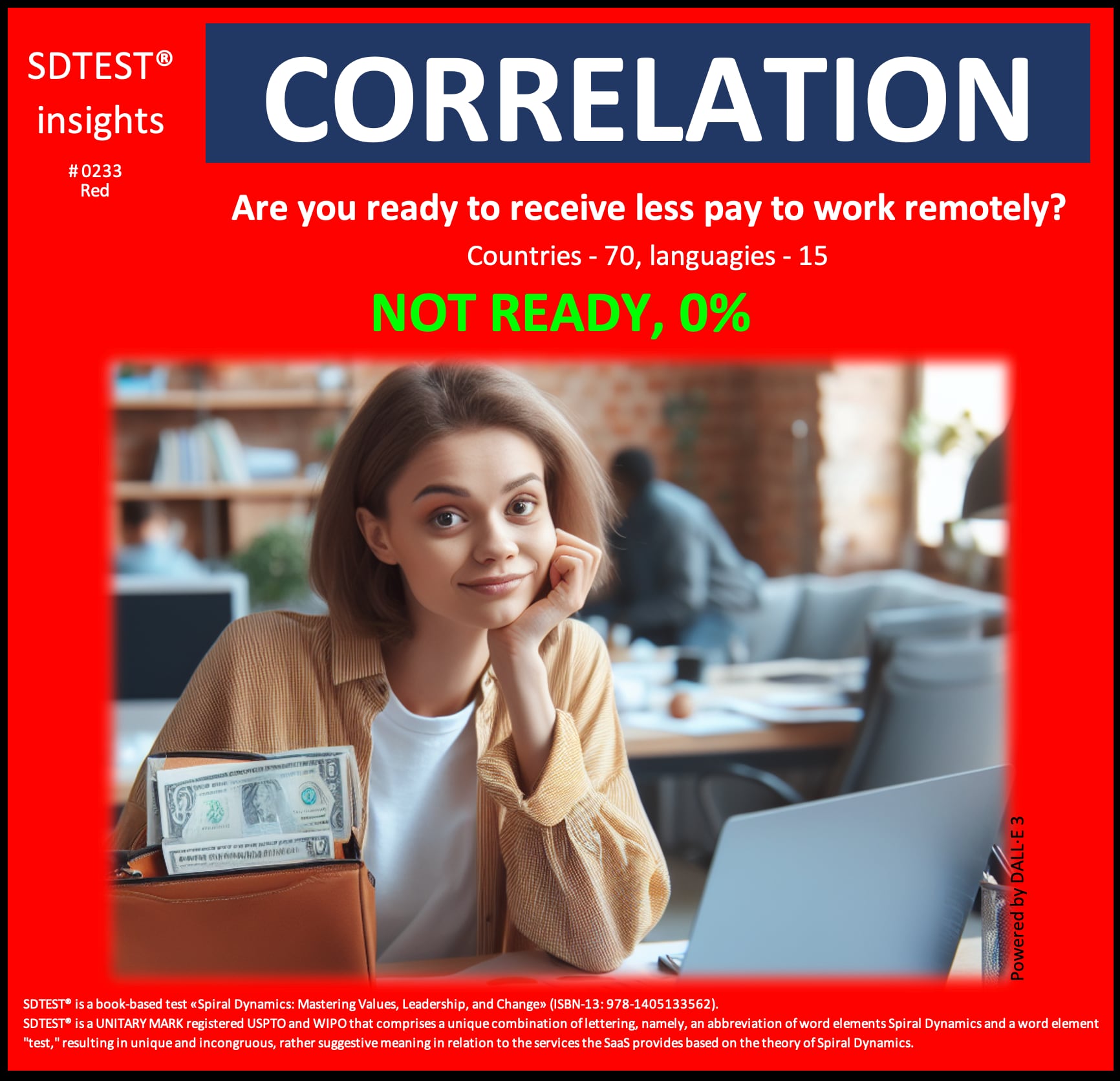
This positive correlation of 0.1242 between not being ready to receive less pay for remote work and the Red stage offers intriguing insights when viewed through the lens of the Red value system:
Organizations operating within the Red mindset might interpret this correlation as:
These organizations might respond by:
Teams operating from a Red mindset might approach this correlation by:
These teams might respond by:
Individuals aligned with the Red value system might interpret this correlation as:
These individuals might respond by:
This correlation, viewed through the Red lens, suggests that those operating at the Red level may be more inclined to view any pay cut as a direct threat to their power and status. It implies that the Red value system's assertiveness, self-interest, and desire for immediate gratification align with a solid resistance to accepting lower pay for remote work.
From this perspective, the correlation invites us to explore how the Red focus on power and dominance influences attitudes towards remote work compensation. It prompts us to ask How the Red value system's emphasis on personal gain and status affects negotiations for remote work arrangements. What are the potential consequences of this uncompromising stance on pay in an evolving work landscape?
Ultimately, this correlation speaks to the complex interplay between the Red value system's drive for power and the changing nature of work. It reminds us that in the Red worldview, maintaining full pay for remote work is seen as a non-negotiable assertion of personal value and dominance, overriding considerations of organizational needs or the potential benefits of flexible work arrangements.
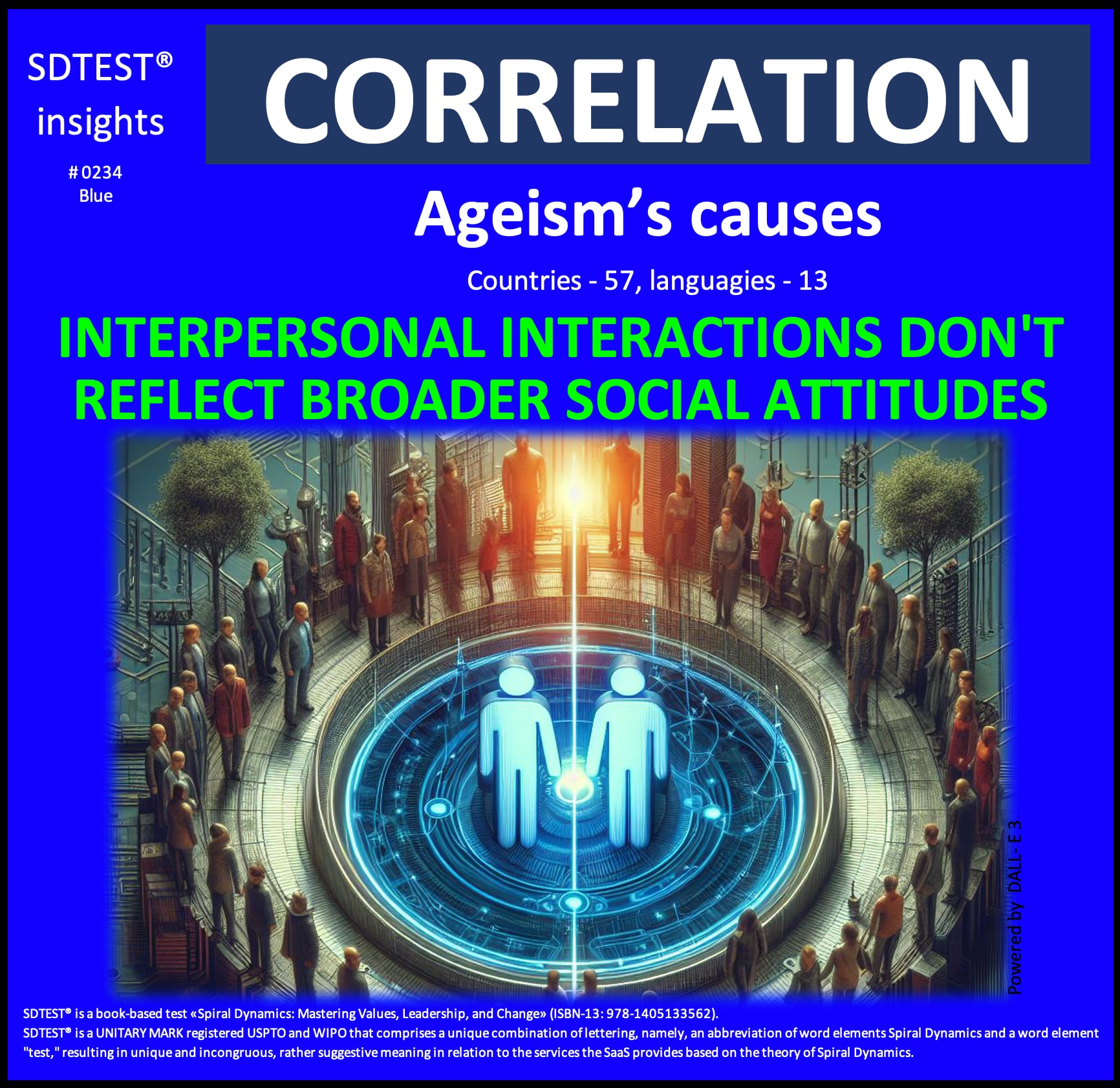
This positive correlation of 0.1351 between believing that interpersonal interactions do not reflect broader social attitudes regarding ageism and the Blue stage offers intriguing insights when viewed through the lens of the Blue value system:
Organizations operating within the Blue mindset might interpret this correlation as:
These organizations might respond by:
Teams operating from a Blue mindset might approach this correlation by:
These teams might respond by:
Individuals aligned with the Blue value system might interpret this correlation as:
These individuals might respond by:
This correlation, viewed through the Blue lens, suggests that those operating at the Blue level may be more inclined to see ageism as a matter of individual conduct and adherence to established norms rather than a reflection of broader social attitudes. It implies that the Blue value system's characteristics of order, discipline, and respect for authority align with a perspective that emphasizes personal responsibility and proper behavior over societal trends.
From this perspective, the correlation invites us to explore the interplay between traditional values and perceptions of ageism. It prompts us to ask: How does the Blue focus on order and individual responsibility influence attitudes towards age-related issues in the workplace? What are the potential consequences of addressing ageism primarily through established rules and protocols rather than considering broader social dynamics?
Ultimately, this correlation speaks to the complex relationship between value systems and perceptions of social issues like ageism. It reminds us that in the Blue worldview, the solution to ageism lies in proper individual conduct, adherence to established norms, and respect for authority and tradition rather than in addressing broader societal attitudes or systemic issues.
0.1047 between the No, ageism doesn't exist within my family and community and the Orange stage.
The critical value of the correlation coefficient for a normal distribution, by William Sealy Gosset (Student) r = 0.0794. This positive correlation of 0.1047 meets the reliability criteria but does not necessarily imply causation.
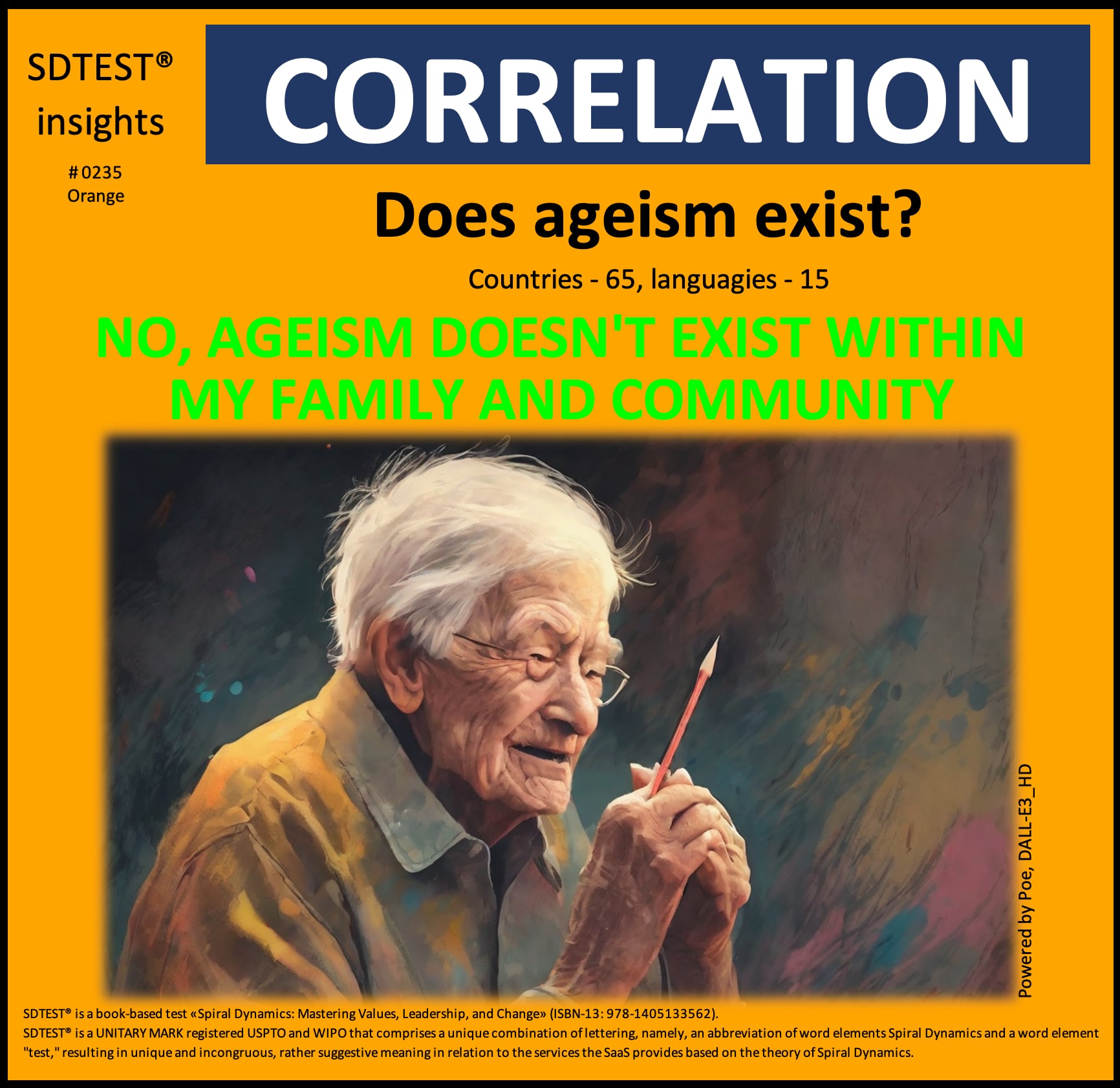
This positive correlation of 0.1047 between believing that ageism doesn't exist within one's family and community and the Orange stage offers intriguing insights when viewed through the lens of the Orange value system:
Organizations operating within the Orange mindset might interpret this correlation as:
These organizations might respond by:
Teams operating from an Orange mindset might approach this correlation by:
These teams might respond by:
Individuals aligned with the Orange value system might interpret this correlation as:
These individuals might respond by:
This correlation, viewed through the Orange lens, suggests that those operating at the Orange level may be more inclined to dismiss the existence of ageism in their immediate environment due to their focus on individual merit and measurable outcomes. It implies that the Orange value system's characteristics of rationality, goal orientation, and emphasis on personal achievement align with a perspective that downplays the impact of age-based discrimination.
From this perspective, the correlation invites us to explore the interplay between meritocratic ideals and the reality of age-related biases. It prompts us to ask: How does the Orange focus on individual achievement and objective metrics influence perceptions of ageism? What are the potential consequences of dismissing ageism favoring a purely performance-based worldview?
Ultimately, this correlation speaks to the complex relationship between value systems and perceptions of social issues like ageism. It reminds us that the emphasis on measurable success and individual merit in the Orange worldview may lead to underestimating systemic age-related biases. This perspective challenges us to consider how we can balance the drive for achievement and efficiency with a nuanced understanding of age-related dynamics in our families, communities, and workplaces.
-0.0709 between the Feel the World owes them something and the Green stage.
The critical value of the correlation coefficient for a normal distribution, by William Sealy Gosset (Student) r = 0.0575. This negative correlation of -0.0709 meets the reliability criteria but does not necessarily imply causation.
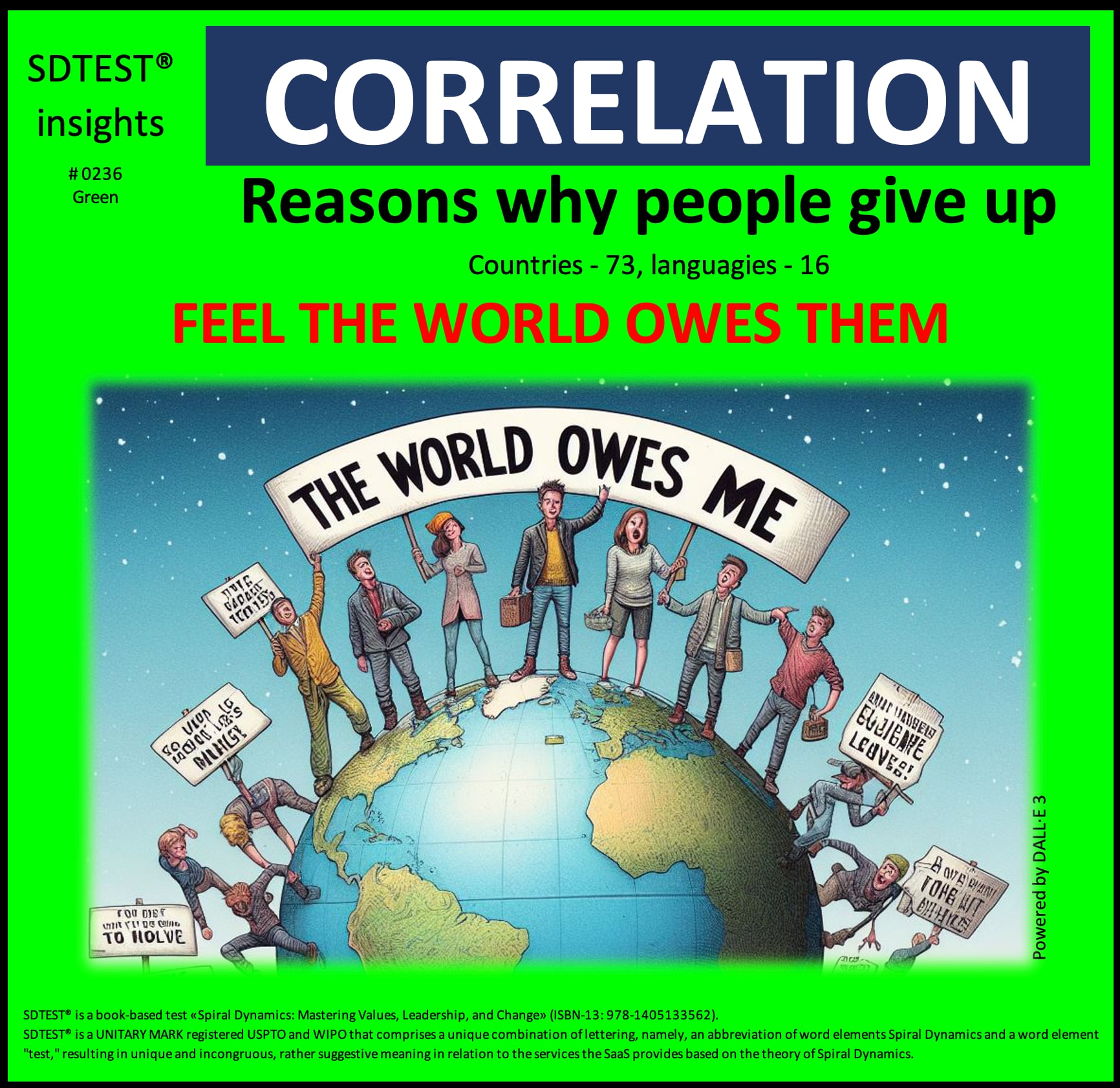
This negative correlation of -0.0709 between feeling that the world owes them something as a reason for giving up and the Green stage offers intriguing insights when viewed through the lens of the Green value system:
Organizations operating within the Green mindset might interpret this correlation as:
These organizations might respond by:
Teams operating from a Green mindset might approach this correlation by:
These teams might respond by:
Individuals aligned with the Green value system might interpret this correlation as:
These individuals might respond by:
This correlation, viewed through the Green lens, suggests that those operating at the Green level may be less likely to give up because they feel the world owes them something. It implies that the Green value system's characteristics of community focus, holistic thinking, and emphasis on interconnectedness align with a perspective that encourages perseverance through a sense of shared responsibility and mutual support.
By focusing on mutual support, personal growth, and contribution to the larger community, those aligned with the Green value system may be better equipped to navigate challenges without succumbing to feelings of entitlement or helplessness. This approach benefits the individual and strengthens the fabric of the entire community, creating a more supportive and resilient environment for all.
Ultimately, this correlation speaks to the complex relationship between value systems and personal resilience. It reminds us that in the Green worldview, the emphasis on community, empathy, and holistic thinking may serve as a powerful antidote to the notion that the world owes us something. This perspective challenges us to consider how we can cultivate a sense of interconnectedness and shared responsibility to build more resilient individuals, teams, and organizations.
0.0933 between the I notice ageism in personal life and the Yellow stage.
The critical value of the correlation coefficient for a normal distribution, by William Sealy Gosset (Student) r = 0.0809. This positive correlation of 0.0933 meets the reliability criteria but does not necessarily imply causation.
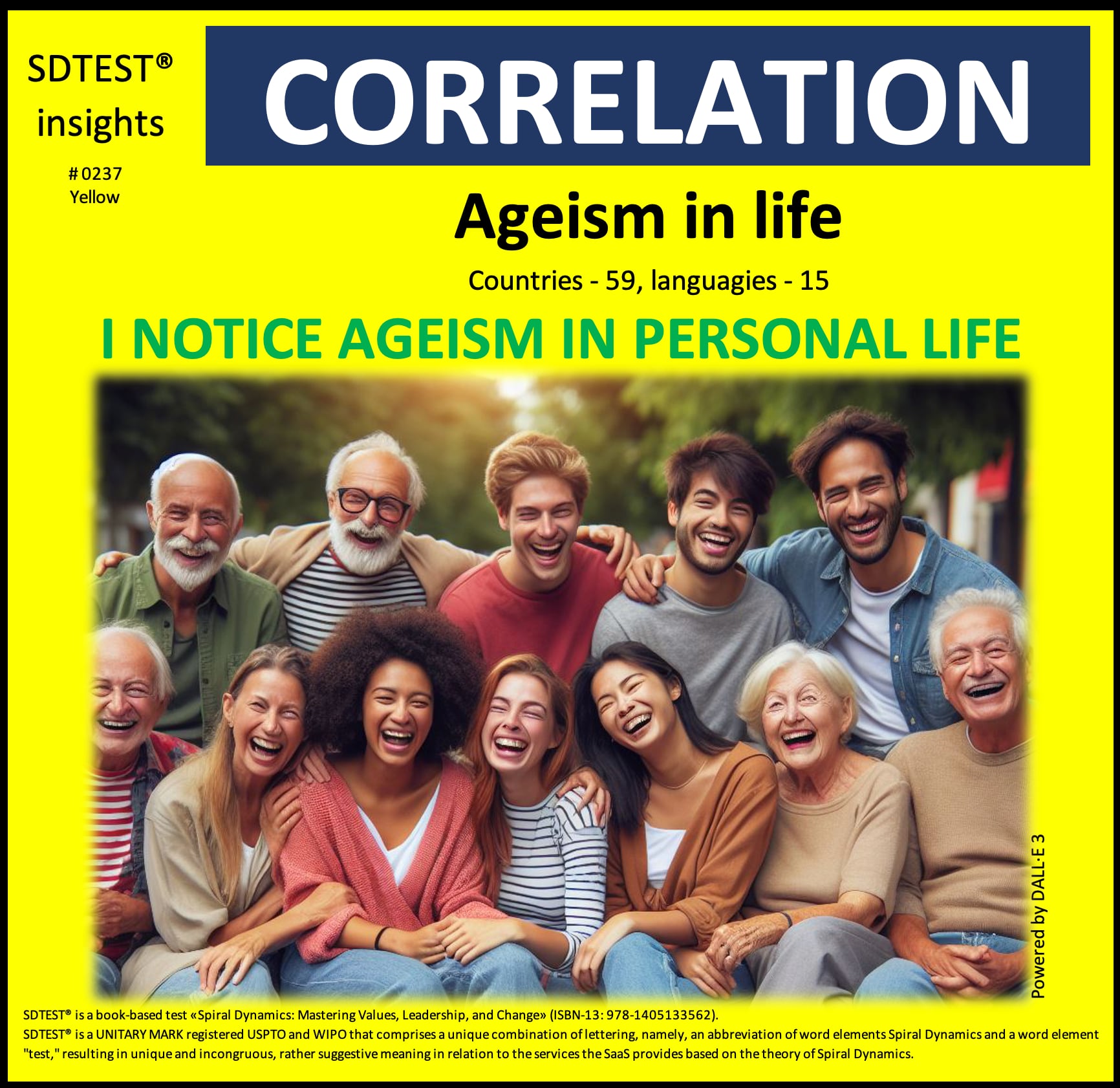
This positive correlation of 0.0933 between noticing ageism in personal life and the Yellow stage offers intriguing insights when viewed through the lens of the Yellow value system:
Companies operating within the Yellow mindset might interpret this correlation as:
These organizations might respond by:
Teams operating from a Yellow mindset might approach this correlation by:
These teams might respond by:
Individuals aligned with the Yellow value system might interpret this correlation as:
These individuals might respond by:
This correlation, viewed through the Yellow lens, suggests that those operating at the Yellow level may be more attuned to noticing subtle forms of ageism in their personal lives. It implies that the Yellow value system's characteristics of integrative thinking, multi-perspective understanding, and systems awareness align with a heightened ability to perceive and analyze complex social dynamics like ageism.
By recognizing ageism as part of a more extensive system of social interactions and biases, those aligned with the Yellow value system may be better equipped to develop innovative, flexible strategies for promoting age inclusivity. This approach benefits individuals and can potentially transform organizations and societies by fostering a more comprehensive understanding of age-related dynamics and their impact on human systems.
Ultimately, this correlation speaks to the complex relationship between value systems and the perception of social issues like ageism. It reminds us that in the Yellow worldview, the ability to notice ageism may be coupled with a nuanced understanding of its systemic nature and interconnections with other social dynamics. This perspective challenges us to consider how to cultivate more integrative, adaptive approaches to addressing ageism that acknowledge its complexity while seeking holistic solutions.
0.1060 between the Yes, the organization benefits from having a working group to keep the conversation on ageism and the Turquoise stage.
The critical value of the correlation coefficient for a normal distribution, by William Sealy Gosset (Student) r = 0.0807. This positive correlation of 0.1060 meets the reliability criteria but does not necessarily imply causation.
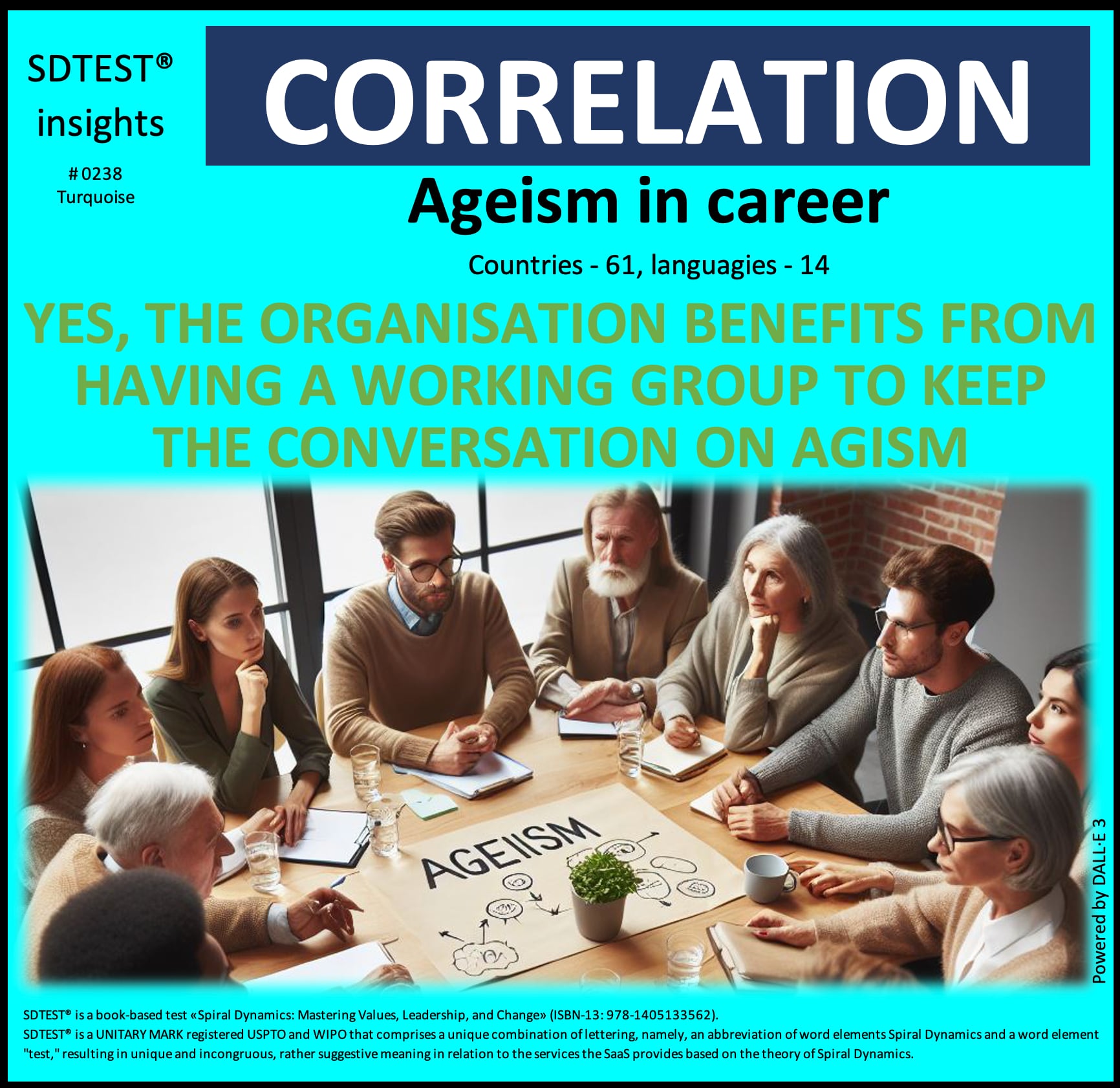
This positive correlation of 0.1060 between supporting organizational working groups on ageism and the Turquoise stage offers intriguing insights when viewed through the lens of the Turquoise value system:
Companies operating within the Turquoise mindset might interpret this correlation as:
These organizations might respond by:
Teams operating from a Turquoise mindset might approach this correlation by:
These teams might respond by:
Individuals aligned with the Turquoise value system might interpret this correlation as:
These individuals might respond by:
This correlation, viewed through the Turquoise lens, suggests that those operating at the Turquoise level may be more supportive of organizational efforts to address ageism through ongoing dialogue and collaboration. It implies that the Turquoise value system's characteristics of holistic thinking, recognition of interconnectedness, and focus on systemic harmony align with a desire for comprehensive, inclusive approaches to addressing age-related biases in the workplace.
In essence, this correlation suggests that the Turquoise approach to ageism in careers goes beyond simple policy changes or awareness campaigns. It points to a more profound transformation of organizational culture that recognizes the inherent value of all age groups and seeks to create a workplace ecosystem where intergenerational wisdom flows freely, contributing to individual fulfillment and collective progress.
Ultimately, this correlation speaks to the complex relationship between value systems and organizational approaches to social issues like ageism. It reminds us that in the Turquoise worldview, addressing ageism is about eliminating discrimination and fostering a deep understanding of the interconnectedness of all age groups within the larger organizational and societal ecosystem.
What insights do you gain from today's correlation? How might we study this relationship more carefully before deducing causation?
We welcome respectful and wise perspectives! Stay tuned every week as we share more results and insights.
After login or registration, free access to the poll results in the FAQ section.
[1] https://www.linkedin.com/in/annavital
